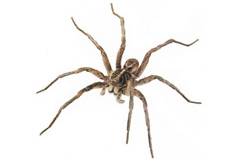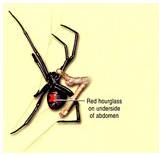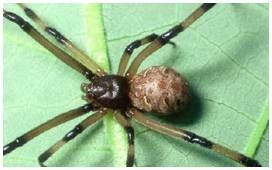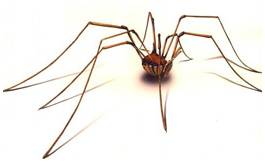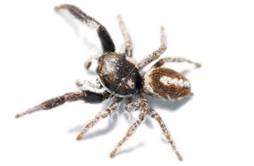Wolf Spider
Wolf spiders are large, hairy spiders that are typically mottled brown to gray in color with various markings or lines. They also have two large, forward-looking eyes in the middle of their face.
Behavior:
Most wolf spiders have stout bodies and long, thick legs. Their bodies are low to the ground even when walking or running, giving them the appearance of continually being on the prowl. As skilled daytime hunters, their dull coloring helps to camouflage them as they hunt along the ground. “Wolf spider” is a common name for any of a group of ground-dwelling hunting spiders that are not associated with webs. The hunting strategies of Florida wolf spiders are perhaps the most diverse of any spider group. Many are active, wandering hunters during the day in sunny areas along the ground and in vegetation; others hunt at night and remain in silk-lined “retreats” during the day. Others live and hunt in aquatic environments, walking on the surface of ponds or on submerged vegetation. Some wolf spiders dig burrows in which they lie in wait for passing insects and other prey. Of the Florida spiders that dig burrows, some add a moveable trap door at the burrow entrance while others build an elevated lookout point. The female wolf spider lays eggs in a large sac, which can often be as large as her own body. She attaches the egg sac to her body, and carries it with her until the eggs hatch. She then tears open the egg sac and the newly hatched spiders climb onto her back where they remain for up to a week. They do not usually breed indoors or in homes.
Habitat:
Wolf spiders are commonly found in gardens, leaf litter and areas of tall grass where they patrol the ground for insects, and similar prey, though they can be found in a variety of habitats. They may also dwell under stones and logs, preferring covered, hidden areas. Wolf spiders are rarely pests, and usually enter structures underneath doors or through cracks in the exterior walls where their size can frighten some.
Bite Signs and Symptoms:
Wolf spiders are not poisonous, and will typically bite only when handled. As with most spiders bites, they may cause reactions in certain individuals.
Control:
Call Custom Pest Solutions if you think you have an infestation. We suggest you keep grass cut low and vegetation from overgrowing in yards and gardens near the home. Disperse rock and lumber piles, and seal any cracks or spaces around plumbing pipes leading indoors. Also, as with most other pests, cover all vents with screening.
Black Widow Spider
The adult female black widow has a shiny, jet-black spherical abdomen with an orange-red hourglass-shaped marking on its underside. The male’s abdomen has red spots and white lines or bars radiating out to its sides
Behavior:
The black widow spider’s venom is a potent neurotoxin and is considered the most venomous spider in North America. However, the female injects such a small dose of venom that it rarely causes death. They are timid and solitary, and often bite only when disturbed. All encounters with humans can be attributed to the female.
Black widow spiders tend to mate during spring or summer. The female lays 25-250 eggs in a ½-inch smooth, white silken sac, several of which may be produced during mating season. The egg sacs are suspended in the web and guarded by the female for about four weeks. They disperse by ballooning-exuding silk threads that are then transported by air currents. They mature in 2-4 months depending on availability of prey. Adults usually have a lifespan of one year. The female constructs a very strong web of crisscrossed silk threads with a dense area of silk, usually to one side, which serves as the spider’s daytime retreat. At night, the female hangs belly upward with the hourglass marking visible, in the center of the web, and does not leave the web voluntarily. The web is usually situated near the ground in a dark, sheltered site. Webs often are one foot in diameter.
Habitat:
Outdoors, black widow spider webs are usually built in wood and debris piles, under eaves, under stones, in hollow stumps, meter boxes, and other secluded areas. They are often found when homeowners carry firewood into the home. Black widows can also be found in outhouses, sheds, and garages. Indoors, they prefer secluded, cluttered areas in attics and crawl spaces. The web serves as a trap for the spider’s food supply, which includes a variety of insects, such as cockroaches and beetles, and other arthropods. The black widow spider is essentially a southern species.
Bite Signs and Symptoms:
The severity of a person’s reaction to the black widow spider bite depends on the area of the body bitten, amount of venom injected, and their sensitivity to the venom. The venom travels in the bloodstream throughout the body and acts on the nervous system, causing varying degrees of pain, which can sometimes be very intense. Since there is no conspicuous swelling, the bite of a black widow spider may initially go unnoticed, but some people report a short stabbing pain. At first, there may be slight local swelling and two faint red marks, which are puncture points from the fangs. Pain soon begins and usually progresses from the bite site to the abdomen and back. Severe cramping or rigidity may occur in the abdominal muscles. Other symptoms may include nausea, profuse perspiration, tremors, difficulty breathing, restlessness, increased blood pressure, and fever. Symptoms often diminish after a day or so and cease after several days. Serious long-term complications or death are very rare. If bitten, remain calm, and immediately seek medical attention (contact your physician, hospital and/or poison control center). Apply an ice pack directly to the bite area to relieve swelling and pain. If possible, preserve the spider, regardless of its condition, for positive identification by a spider expert. A plastic bag or small jar or vial can be used to preserve it. A hospital stay may be recommended, particularly for those with a heart condition or with health problems. A physician may administer a specific antivenin to counteract the venom or to relieve pain.
Control:
In order to prevent spider bites, be sure to wear gloves and a long-sleeved shirt when handling stored cardboard boxes, firewood, lumber, and rocks. Be sure to inspect these clothing items for spiders before putting them on. Shake out clothing and shoes before getting dressed. Install tight-fitting screens on doors and windows to prevent entry of black widow spiders. Seal or caulk cracks and crevices where spiders can enter the house. Install yellow or sodium vapor light bulbs outdoors since these attract fewer insects for spiders to feed upon. Discard old boxes, old clothing, lumber, and other unwanted items in attics, crawl spaces, garages, etc. In such areas, store any items off the floor and away from walls. Disperse piles of lumber and debris outdoors. Do not store firewood against the house. If you think you have an infestation, call Custom Pest Solutions right away.
Brown Widow Spider
Brown widows vary in color from light tan to dark brown or black, with black, white, yellow, orange, or brown markings on their abdomens. The underside contains the hourglass marking, which is orange to yellow-orange, and the legs have dark bands.
Behavior:
The brown widow spider can produce 10-20 egg sacs, each containing up to 250 eggs. Unlike the other widow species’ smooth egg sacs, the brown widow spider’s egg sac is tan and covered with many pointed projections, and can have a fluffy appearance. Aside from its dark brown color, this characteristic is the one that most clearly differentiates the brown widow from the western and southern black widow. They can be easily spotted within the web, most often in the tunnel section where the female lives. Their webs are usually about a foot and a half in diameter. The egg sac is attached to the web, and after two weeks will hatch. The spiderlings remain in the nest area for several weeks where they undergo 6-9 molts before reaching maturity and drifting off on silken threads propelled by air currents. Female brown widows can live up to a year when food, which consists mainly of insects, is available.
Habitat:
The brown widow spider is the most abundant and is commonly found in urban areas. They favor outdoor hiding places such as the crawl space beneath homes and among piles of stored lumber, hollow tile blocks, stored items on shelves, and in abandoned vehicles, storage sheds and utility ducts. Within the home, the brown widow may be found beneath tables and desks, behind shutters, in the angles of doors and windows, in the folds of clothing, in shoes, and under objects in dark, secluded areas. Brown widow spiders are shy and will tend to avoid contact with humans. Females are not aggressive and usually make no effort to attack, preferring instead to retreat and lie perfectly still. When confronted or provoked, however, they will bite and can inject a neurotoxic venom.
Bite Signs and Symptoms:
The bite from the brown widow spider causes a set of symptoms in the bite victim known collectively as latrodectism, which is caused by the neurotoxins in its venom. The initial bite has been likened to a pinprick - it is often painless and goes unnoticed. The toxin then travels through the nervous system. The first significant symptom is a dull, numbing ache in the region of the actual bite. This ache may progress to painful muscle cramps in the large muscle masses of the body, particularly the abdomen. Additional symptoms may include sweating, nausea, a rise in blood pressure, leg cramps, muscle tremors, loss of muscle tone, irregular heartbeat, and vomiting. Symptoms and pain begin between 15 and 60 minutes after the bite and generally peak within one to three hours. Symptoms usually disappear within 12 to 24 hours. Fatal bites are extremely rare. Very young children and elderly adults are the most susceptible to the brown widow’s venom and are therefore the most likely to experience severe symptoms.
Control:
Call Custom Pest Solutions if you think you have an infestation. We recommend that when working outdoors, wear gloves and long-sleeved shirts and pants when handling firewood or other items that have been stored outdoors or in tool sheds. Inspect and shake out shoes and clothing that have been stored in the garage or attic before bringing them inside or putting them on.
Check firewood and other items stored outdoors for cobwebs and spiders before bringing them inside the home. Eliminate harborages: Keep indoor closets, attics, and basements dry by either increasing ventilation or using a dehumidifier. Remove clutter and move boxes or other objects off the floor and away from the wall to eliminate possible spider nesting sites. Seal any openings around pipes and seal cracks around doors and windows to keep them from entering the home.
Daddy Long Legs
Daddy Long Legs spiders are gray to light brown in color. They have a rectangular, elongated abdomen and four pairs of long, slender legs that may be up to 30 times as long as its body, causing them to appear much larger than they actually are.
Behavior:
Adults tend to hide during the day and become active at night when they search for food such as plant juices, dead and sometimes living insects. When they move the second pair of legs, the longest, touch the surface in search of food. If something edible is found, it begins a teetering motion and tilts its body forward ands grabs its prey. When a daddy long legs web is disturbed or when large prey gets entangled in their web, it vibrates rapidly in a gyrating motion, becoming blurred and making it difficult for a predator to see where the spider is. It is also helpful for capturing insects that have brushed their web and may still be nearby. Because of this behavior it is sometimes referred to as a “vibrating spider”.
Habitat:
Daddy long legs spiders hang inverted in messy, irregular, tangled webs. These webs are constructed in dark and damp recesses, in caves, under rocks and loose bark, abandoned rodent burrows, and undisturbed areas in buildings and cellars, hence the common name "cellar spiders". Certain species of daddy long legs invade webs of other spiders and eat the host, eggs, or prey. In some cases the spider vibrates the web of other spiders, mimicking the feel of struggling prey, to lure the web’s host out in the open. They are known to attack and eat Redback and Huntsman spiders.
Interesting Fact:
If the daddy long-legs is in danger of being caught, it can break off a portion of its legs and then escape while the detached legs continue to quiver in front of a confounded predator. Daddy long-legs can grow new legs to replace the broken ones.
Control:
These spiders are harmless to man as their jaws are unable to penetrate human skin, and the venom dose is also too minute. Their venom is neurotoxic but is only deadly to its prey. They are sometimes left alone in the home as they control various insect pests such as mosquitoes, flies, ants and moths.
Jumping Spiders
Jumping spider females are generally larger than males. Jumping spiders are among the most ornate of spiders; many species are brightly colored and strikingly patterned, with stout bodies, short legs, and four pairs of eyes (two of which are front and center, like headlights) that can identify prey, predators and mates from up to a foot away.
Behavior:
“Jumping Spider” is the common name for any of a group of hunting spiders that can leap 10 to 40 times their body length. With over 4000 described species, they comprise the largest family of spiders.
The male's front pair of legs are colored with distinctive bands of hair. In many species the male performs complex courtship displays in which he bobs his body and waves his front legs in a highly specific manner. After mating, the female lays her eggs in a silk-lined shelter under stones or bark, or on the surface of plants. The female will often guard the eggs and newly hatched young. The jumping spider is an active predator, usually hunting during daylight. It will stalk to within a few body lengths of the prey, crouch, crawl slowly forward, and then lift its front legs and pounce. Before pouncing on the victim, jumping spiders attach a line of silk from which they can dangle if they fall. It accomplishes its spectacular jumps by means of muscular contractions in the body that force body fluids into the legs, causing the legs to extend rapidly. Most jumping spiders feed on insects, while others feed primarily on web-building spiders.
Habitat:
Jumping spiders live in a variety of habitats. Tropical forests harbor the most species, but they are also found in temperate forestss, scrub lands, deserts, and even mountains. More than 300 species have been described in the United States. They usually live outside near plant foliage, fences, walls, decks, and patios. Unlike almost all other spiders, they can also climb on glass.
Bite Signs and Symptoms:
The jumping spider is probably the most common biting spider in the United States. People are caught by surprise and scared when they see the spider jump, especially if it jumps towards them. Bites from a jumping spider can sometimes be painful, itchy and cause redness and minor swelling.
Control:
This kind of spider you can handle on your own since jumping spiders cause no immediate threat they are not considered house pests. They can easily be dispensed of with a napkin or trapped with a paper cup.

